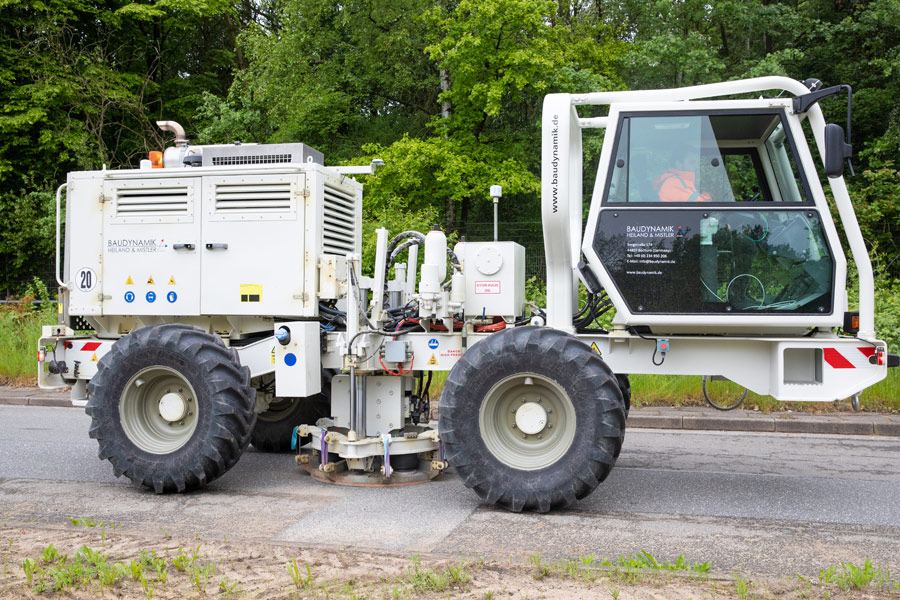Measuring WAVEs for science
Demonstration study on seismic network at DESY´s Bahrenfeld campus published
For the first time, researchers from Universität Hamburg, DESY, and the German Research Centre for Geosciences (GFZ) Potsdam have used a fibre-optic network to measure ground vibrations and oscillations at DESY´s Bahrenfeld research campus and to analyse their causes. In their now-published demonstration study of this novel measurement method, the WAVE collaboration describes how sensitively such a seismic network on the campus can measure the effects of seismically transmitted disturbances. The study also includes ideas for building a seismic network as part of the research infrastructure on campus.

Oscillations and vibrations in the ground are two of the main enemies of high-precision research at DESY and its research partners. Whether natural in origin or man-made, vibrations are transmitted to particle accelerators and sensitive experiments, limiting the capabilities or accuracy of these facilities. As part of the WAVE initiative, which is also supported by the Clusters of Excellence Quantum Universe and Climate, Climate Change and Society (CliCCS), researchers are developing methods with which disturbances transmitted by ground vibrations can be measured and extracted from the measurement data of experiments or compensated for during operation of the research facilities. “This is an important step towards improving measurement data,” explains Oliver Gerberding from the Cluster of Excellence Quantum Universe at Universität Hamburg and adds: “WAVE could become an international lighthouse project in the coming years.” The so-called seismic noise can have a variety of causes. “In addition to natural phenomena such as earthquakes, tides or ocean waves, human activities, such as traffic or construction work, also cause disturbance signals that are transmitted through the ground,” explains geophysicist Céline Hadziioannou from the Cluster of Excellence CliCCS. Holger Schlarb from the Machine Beam Controls group at DESY adds: “The innovative approach of our measurement method enables large-scale monitoring of the infrastructure in the vicinity of accelerator facilities and, above all, a rapid response to disturbances that arise there, for example due to the operation of air conditioning systems or pumps.” In the data collected as part of the demonstration study, the researchers were able to detect not only ground vibrations caused, for example, by the hum of the mains in transformer houses, but even those from announcements over speakers in the accelerator tunnel.
To measure the vibrations, the researchers used a so-called seismic network. It consists of distributed acoustic sensing (DAS) sensors. The technology is based on fibre optic cables that are laid specifically for the measurements, but it can also use existing fibre optic cables from telecommunications. A laser pulse is injected into the optical fibre and laser interferometry is used to measure the strain and compression of the optical fibre cables caused by the ground vibrations to the nearest metre. The same method can be used to measure the transmission of acoustic signals audible to the human ear. The demonstration study of the WAVE Initiative is based on measurements along a 12-kilometre-long strand of existing optical fibre cables, which run in the PETRA III experiment hall Max von Laue and in the tunnel of the X-ray laser European XFEL, among other places.

Physicists Oliver Gerberding and Roman Schnabel are developing components for gravitational wave detectors at the Quantum Universe Cluster of Excellence at Universität Hamburg. “For the measurement of gravitational waves, a high precision of the detector is necessary. With the help of seismic networks, so-called Newtonian noise, i.e. the disturbance caused by gravitational effects of attracting masses, can be determined.”
Knowledge of seismic disturbances on campus is also an asset for all research facilities and laboratories on site. For the research centre DESY, seismically transmitted disturbances have great relevance with regard to large-scale research facilities, such as the European XFEL, the measuring stations at the high-power X-ray source PETRA III, and the future PETRA IV facility. “We have tracked vibrations from 10 millihertz up to 500 hertz and identified a wide variety of vibration sources,” says Holger Schlarb. “With a permanent installation of such a measurement network, we could study the influence on the experiments and the possibilities to avoid it in detail. Research at our facility could benefit enormously from this.” The system could also be used to set up a kind of early warning system for ageing and thus noise-causing fans, flaps or other technical components.
For geophysicist Céline Hadziioannou and her colleague Dirk Gajewski from the Cluster of Excellence CliCCS, beyond researching the technology of seismic networks, an application related to smart city concepts, as well as sustainability and urban security in cities is of interest.
Further Information
Website of the WAVE initiative
